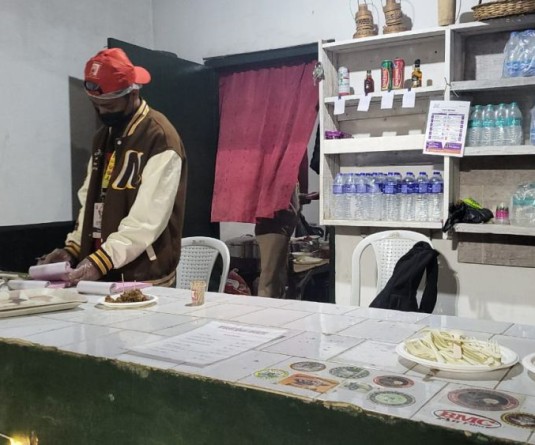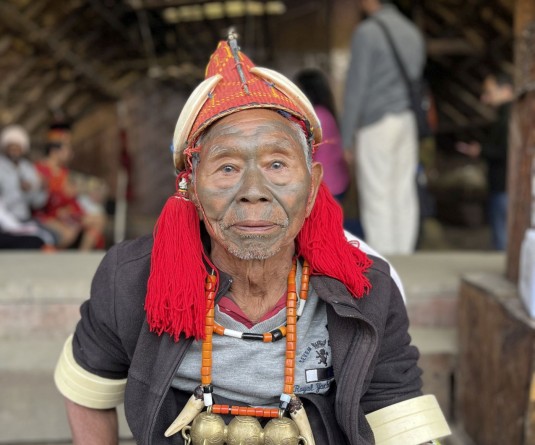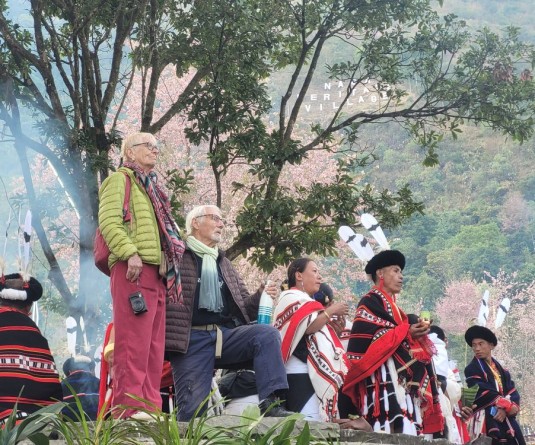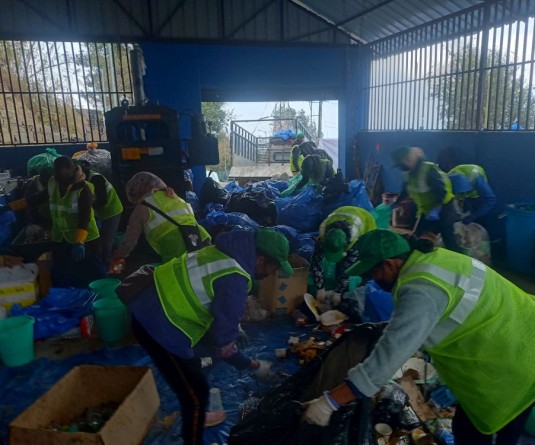Rev Hojevi Kappo demonstrates the Indigenous Wind Chime (Qü Qü Pu) which he has improvised using coconut shell.

Akangjungla
Dimapur | November 30
Since the dawn of time music has been the primary way of communication for Indigenous Peoples. Referred as Traditional or Indigenous Music, the songs of Indigenous Peoples across the world are deeply rooted in their ancestors’ cultural, spiritual, and community practices and knowledge, serving as a crucial tool for storytelling and preservation of cultural inheritance for future generations. Over the years music in Nagaland has adapted and evolved. Lately the Naga peoples, as an Indigenous community are beginning to see the rich worth and the deep knowledge embedded in their original songs and becoming aware of the loss of Naga Indigenous Music.
In a conversation with The Morung Express, Reverend Hojevi Kappo, a champion of Naga Indigenous Music talks about its huge importance.
.webp)


Kappo, founder and leader of Nagagenous (Indigenous Music and Art performing team) is a recipient of Governor Award 2011 in Field of Music & Arts. With his initiative, Afuko College of Music and Indigenous Arts ‘dedicated to preservation, promotion and training of Naga Indigenous Music’ was established in 2023 under Western Sümi Baptist Akukuhou Küqhakulu.
Kappo, who is a theological graduate and musically trained from Philippines, has represented Nagas as a music ambassador to several international events in places like Amsterdam, Thailand, UK, US, South Korea and Malaysia. He is also a pioneer and former conductor of The Nagaland Chamber Choir.
In the path of Indigenous Music
Kappo’s calling to the path of Indigenous Music came in 1993, when during an international gathering in Philippines he was asked to sing a traditional song. Not knowing ‘any traditional song’ he sang an “English song.”
“A person in the gathering asked if it was my traditional song. I said no. That was the first time I was embarrassed… I started thinking of my own culture and my own music; and also what the outside world expect from us,” he recollected.
Since then Kappo has been on his enduring journey as a Naga Indigenous musician.
Asserting Naga Indigenous Music as ‘the real culture and music,’ he said traditional songs are ingrained with rich stories and records of our predecessors. “We should be proud of our own songs. Our Indigenous songs and musical instrument are very simple, yet it recounts who we are as Naga people,” he said.
Effects of Colonialism on Indigenous Music
Despite the enormous value of traditional songs as a storehouse of knowledge, the Indigenous communities globally are facing challenges resulting from colonisation and the declining number of traditional knowledge holders.
For instance, introduction of Christianity to Naga people brought the influence of colonialism and imposition of western culture. Kappo agreed that censuring of Naga culture as pagan made the forefathers to burn everything. “We lost so much culture.”
Although Indigenous Music is threatened by western music, Kappo does not discredit the one from the other. ‘Both should exists and grow equally. If we have a strong base of indigenous music, our own art can grow along with the western music.’
“Cover songs do not sustain as it can be replaced. The glory is just for a short period of time. But Indigenous Music stays as long as 20 years,” he said.
A medium to connect
Inorder to retrieve and nurture Indigenous Music, Kappo acknowledged the need to have a connecting bridge between the traditional song keepers and the younger generation.
“The real story-tellers are in the villages, whereas most of us have migrated.” The blame cannot be put on the elders for failing to connect our tradition with young people because the question of survival became more important back then, he said.
“The real material and resources are with elders in the village. We have to go and listen to their stories and experiences. We also need to revive our old indigenous musical instruments,” he said.
However, he understood that not all young people can go back to the village or bring the old people to them. “Among the elderly people, now only few know the song or have an authentic recollection of what happened. With age, memories are muddled up.”
“We are not advancing is music. Young musicians do not take the challenge to write their own original traditional songs,” he said.
On the pressing need for more composers who can create traditional songs and skills, Kappo encouraged Naga musicians to create simple melody based on the existing indigenous music, and from there expand the piece with the knowledge of music theory and technique.
In 2023, Kappo produced a children hymnal in Sumi language with 117 songs. It included translation of other music as well as his original compositions.
Indigenous Music and policy matters
With a flicker of hope in his eyes, the Reverend recognised that in the recent times “there is a certain kind of appreciation to be original and sense of belonging” among the younger generation and therefore, more needs to be done to bring Indigenous Music to a more dominant level.
To push forward Naga Indigenous Music, Kappo said, “If the Nagaland Government wants to concentrate on Naga music, they can definitely do so.” However, it requires the “right people” in position- “people who are aware, conscious and passionate about keeping Indigenous Music alive forever.”
“Task Force for Music & Arts (TaFMA) can take the lead,” he remarked.
On lack of written documents on Naga cultural heritage, the suggestion was to have State Government funding for research and documentations.
Another critical requirement was to have Naga music curriculum. “Now that people are more conscious and aware, we can creatively use whatever we have and bring it back to our culture, put a structure, a curriculum, and then we will know how to teach Indigenous Music and show the way forward.”
“I really wish to have a Naga Indigenous Music curriculum in Nagaland University so that even the outside world can come and learn in our own soil,” Kappo said.
Not having written material is the challenge, he informed. “University guidelines require written documents to be put in the form of formal curriculum.” Referring to a meeting held to deliberate on Naga music curriculum, Kappo maintained that every Naga community should take the responsibility to bring their own written document. “Individual musician, no matter how expert they may be, cannot bring out all the Naga peoples music. That will take years…”
Music belongs to the people. “It is not the job of the musicians alone to promote it. People from all walks of life must contribute,” he said.
The crusader hopes to live his dream to restore, improvise and gift Naga Indigenous Music “to such a level that we take pride in our songs and also present it to the world.”






